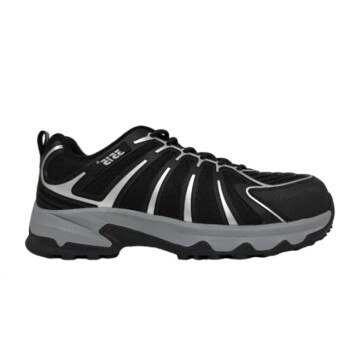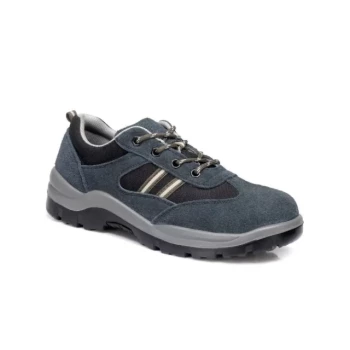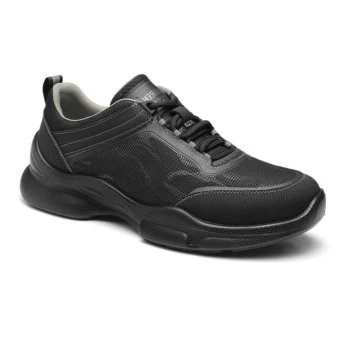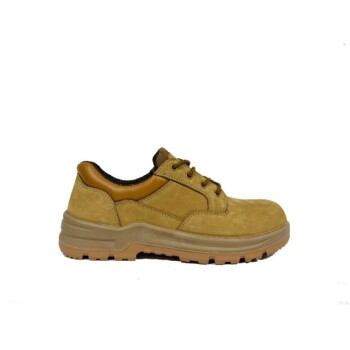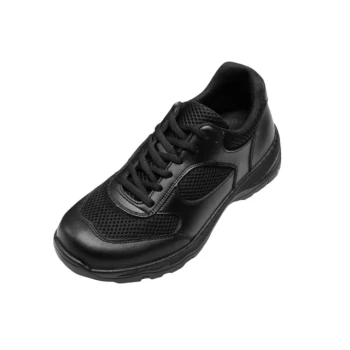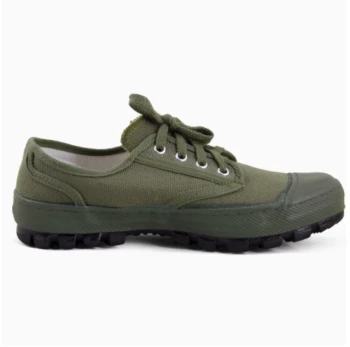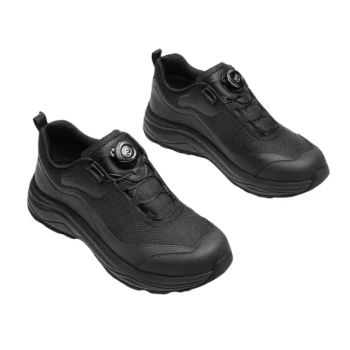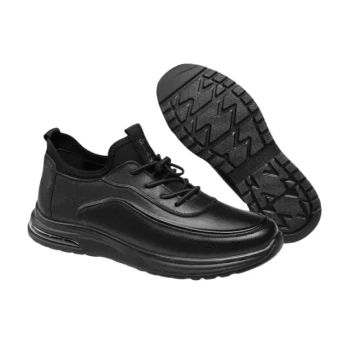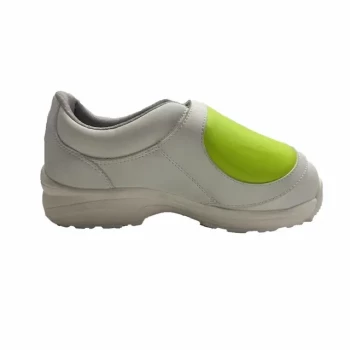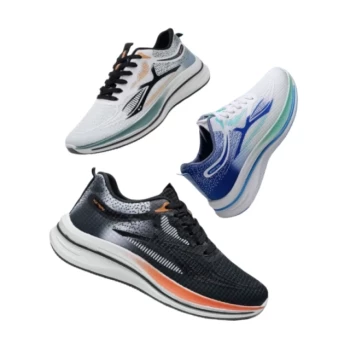Properly selected footwear is your most direct defense against slip, trip, and fall incidents. The key lies in matching the outsole's tread design and material composition to the specific walking surfaces and potential contaminants you will encounter, ensuring the shoe can maintain maximum contact and grip.
The most effective safety footwear doesn't just have "good grip"; it has the correct type of grip, support, and fit specifically engineered for the hazards of its intended environment. A mismatch between the shoe and the hazard can render its safety features useless.
The Science of Slip Resistance
To understand how footwear prevents slips, you must look at the interaction between the outsole (the bottom of the shoe) and the ground. The goal is to maximize the coefficient of friction, which is the technical measure of "grippiness."
The Role of Outsole Tread
The pattern on the bottom of your shoe is its most critical feature for preventing slips on contaminated surfaces. Good tread designs, like the tires on a car, are engineered to channel fluids like water or oil away from the sole.
This channeling action allows the solid parts of the outsole to make direct contact with the walking surface, dramatically increasing friction and preventing hydroplaning.
The Importance of Material Compound
The material of the outsole is just as important as its pattern. Softer rubber compounds generally offer better grip, especially on smooth, wet surfaces, because they can conform more effectively to microscopic imperfections in the floor.
However, harder materials like polyurethane are often more durable and resistant to chemicals and abrasion. The choice depends on the specific hazard.
How Fit Prevents Trips
A trip occurs when your foot catches on an object, causing you to lose balance. Footwear that is too large, loose, or has a bulky sole profile significantly increases this risk.
A snug fit ensures the shoe moves with your foot, providing better control and awareness of your foot's position. Features like a beveled heel can also help the foot roll over small obstructions rather than catching on them.
A Holistic Approach to Footwear Safety
While slip resistance is critical, a comprehensive safety strategy considers other hazards identified through a risk assessment. The right shoe must address the complete picture of your environment.
Protection from Other Hazards
Your workplace may have risks beyond slippery floors. Safety footwear is designed with features like steel or composite toes to protect against falling objects, puncture-resistant plates for sharp objects, and specialized materials for electrical or chemical hazards.
Support to Mitigate Fall Injury
Even with the best footwear, a fall can still occur. Proper ankle support, especially in high-top or boot-style footwear, can prevent severe sprains and fractures if you lose your footing on uneven ground.
Cushioning in the midsole also helps absorb impact, reducing stress on your joints during the fall and throughout the workday.
Understanding the Trade-offs
There is no single "perfect" safety shoe for every situation. Choosing the right footwear always involves balancing competing priorities.
Grip vs. Durability
As a general rule, the softer the outsole material, the better its grip but the faster it will wear down. You must decide whether to prioritize maximum slip resistance or longer footwear life based on the level of risk.
Protection vs. Fatigue
Heavily protected footwear with steel toes and puncture plates offers maximum safety from impacts but is also heavier. This added weight can cause fatigue over a long shift, which can paradoxically increase the risk of a trip or a stumble due to exhaustion.
Specialization vs. General Use
A boot designed with deep lugs for loose gravel and mud will perform poorly on a smooth, greasy kitchen floor. The deep channels that work well outdoors offer very little surface area for gripping a flat floor. Always select footwear specialized for the primary hazard you face.
How to Select the Right Footwear for Your Environment
Your selection process should begin with a clear understanding of your environment and tasks.
- If your primary hazard is wet or oily indoor surfaces: Prioritize a soft, slip-resistant rubber sole with a dense tread pattern designed to channel away liquids.
- If your primary hazard is uneven outdoor terrain: Choose a boot with deep, aggressive lugs for traction and robust ankle support to prevent twists.
- If your primary hazard is tripping over clutter or thresholds: Focus on a snug-fitting shoe with a low-profile sole and a beveled heel.
- If you face multiple hazards like impacts and slips: Select a certified safety shoe that specifies both its impact rating (e.g., ASTM F2413) and its slip resistance.
By matching the shoe to the specific hazard, you transform footwear from a simple requirement into a critical piece of safety equipment.
Summary Table:
| Key Factor | How It Reduces Risk | Ideal For Hazard Type |
|---|---|---|
| Outsole Tread | Channels fluids away for direct surface contact, preventing hydroplaning. | Wet or oily indoor surfaces. |
| Material Compound | Soft rubber conforms to floor imperfections for better grip; harder materials offer durability. | Smooth, wet surfaces vs. abrasive/chemical environments. |
| Proper Fit & Design | Snug fit and beveled heel prevent tripping and improve control. | Cluttered areas, uneven thresholds. |
| Ankle Support & Cushioning | Prevents sprains and absorbs impact, reducing injury severity from a fall. | Uneven outdoor terrain, long shifts. |
Ready to equip your workforce with the right defense against slips and falls?
As a large-scale manufacturer, 3515 produces a comprehensive range of specialized safety footwear for distributors, brand owners, and bulk clients. Our production capabilities encompass all types of shoes and boots engineered for specific hazards—from soft-compound soles for wet kitchens to durable boots with deep lugs for outdoor terrain.
We can help you select or customize the perfect footwear to match your unique environment, ensuring maximum safety and compliance. Contact our experts today for a consultation and let us enhance your workplace safety program.
Get a Free Consultation & Quote Now
Related Products
- Premium KPU Athletic Safety Shoes for Wholesale
- Custom Safety Shoe Manufacturer for Wholesale & OEM Brands
- Durable Rubber-Soled Utility Shoes for Wholesale & Custom Brand Manufacturing
- Wholesale Leather Safety Boots with Customizable Protective Toe
- Wholesale Durable Breathable Safety Boots Custom OEM Manufacturer
People Also Ask
- What are the EN ISO 20345 norms for safety shoes? A Guide to Choosing the Right Protection
- Why is expert help recommended when selecting safety shoes? Ensure Perfect Fit & Hazard Protection
- How is puncture resistance evaluated in footwear soles? Balance Protection, Comfort & Safety
- What should warehouse work shoes include for safety? Essential Features for All-Day Protection
- What are the conditions faced by employees in meatpacking and poultry slaughter plants? Navigating Pervasive Slip Hazards
